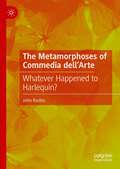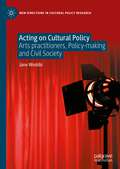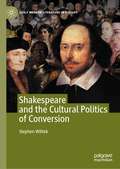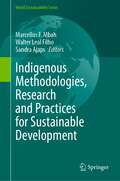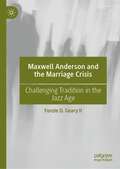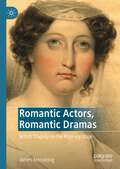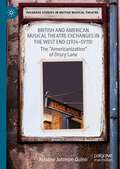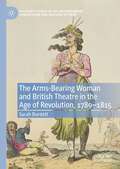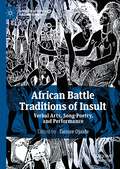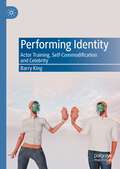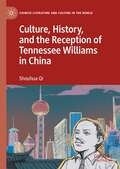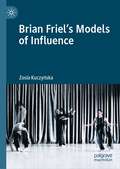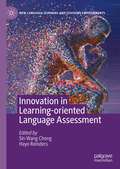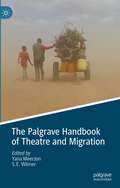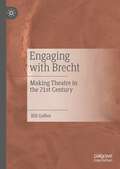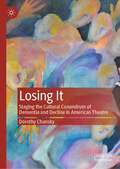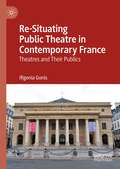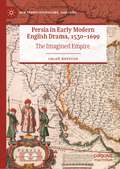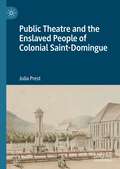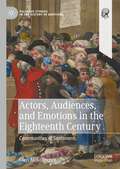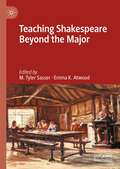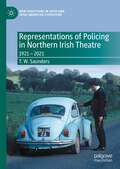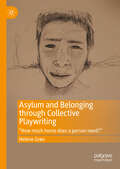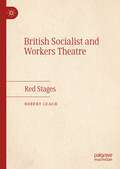- Table View
- List View
The Metamorphoses of Commedia dell’Arte: Whatever Happened to Harlequin?
by John RudlinThe Metamorphoses of Commedia dell’Arte traces the steps by which Commedia has been transformed by cultural contact outside Italy into popular forms which bear little resemblance to the original. The book follows the Masks of Arlecchino, Pedrolino and Pulcinella as they gradually migrate and mutate into Harlequin, Mr. Punch and seaside Pierrot troupes. What happened to Pantalone, Scaramouche, Colombina and the male Lover is also investigated, though they had no final forms of their own. This study constitutes a history of what happened, notably in France and Great Britain, to a supremely popular theatrical genre as a result of changing fashions in entertainment brought on by societal developments, civil and industrial revolution and dynastic change. It investigates how the genre was exploited by management, and even its own stars, lost its vitality and gradually ended up in ‘sunken’ forms.
Acting on Cultural Policy: Arts Practitioners, Policy-Making and Civil Society (New Directions in Cultural Policy Research)
by Jane WoddisThis book investigates the role of arts practitioners in cultural policy-making, challenging the perception that arts practitioners have little or no involvement in policy and seeking to discover the extent and form of their engagement. Examining the subject through a case-study of playwriting policy in England since 1945, and paying particular attention to playwrights’ organisations and their history of self-directed activity, the book explores practitioners’ participation in cultural policy-making, encompassing both “invited” and “uninvited” interventions that also weave together policy activity and creative practice. It discusses why their involvement matters, and argues that arts practitioners and their organisations can be understood as participants in civil society whose policy activity contributes to the maintenance and enlargement of democratic practices and values.
Shakespeare and the Cultural Politics of Conversion (Early Modern Literature in History)
by Stephen WittekThis book takes a close look at Shakespeare’s engagement with the flurry of controversy and activity surrounding the concept of conversion in post-Reformation England. For playhouse audiences during the period, conversional thought encompassed a markedly diverse, fluid amalgamation of ideas, practices, and arguments centered on the means by which an individual could move from one category of identity to another. In an analysis that includes chapter-length readings of The Taming of the Shrew, Henry IV Part I, The Merchant of Venice, Othello, and The Tempest, the book argues that Shakespearean drama made a unique and substantive intervention in public discourse surrounding conversion, and continues to speak meaningfully about conversional experience for audiences in the present age. It will be of particular benefit to students and scholars with an interest in theatrical history, performance theory, theology, cultural studies, race studies, and gender studies.
Indigenous Methodologies, Research and Practices for Sustainable Development (World Sustainability Series)
by Walter Leal Filho Marcellus F. Mbah Sandra AjapsThis book states that whilst academic research has long been grounded on the idea of western or scientific epistemologies, this often does not capture the uniqueness of Indigenous contexts, and particularly as it relates to the achievement of the United Nations Sustainable Development Goals (SDGs). The SDGs were announced in 2015, accompanied by 17 goals and 169 targets. These goals are the means through which Agenda 2030 for sustainable development is to be pursued and realised over the next 15 years, and the contributions of Indigenous peoples are essential to achieving these goals.Indigenous peoples can be found in practically every region of the world, living on ancestral homelands in major cities, rainforests, mountain regions, desert plains, the arctic, and small Pacific Islands. Their languages, knowledges, and values are rooted in the landscapes and natural resources within their territories.However, many Indigenous peoples are now minorities within their homelands and globally, and there is a dearth of research based on Indigenous epistemologies and methodologies. Furthermore, academic research on Indigenous peoples is typically based on western lenses. Thus, the paucity of Indigenous methodologies within mainstream research discourses present challenges for implementing practical research designs and interpretations that can address epistemological distinctiveness within Indigenous communities.There is therefore the need to articulate, as well as bring to the nexus of research aimed at fostering sustainable development, a decolonising perspective in research design and practice.This is what this book wants to achieve. The contributions critically reflect on Indigenous approaches to research design and implementation, towards achieving the sustainable development goals, as well as the associated challenges and opportunities. The contributions also advanced knowledge, theory, and practice of Indigenous methodologies for sustainable development.
Maxwell Anderson and the Marriage Crisis: Challenging Tradition in the Jazz Age
by Fonzie D. Geary IIThis book focuses on the re-evaluation of four Maxwell Anderson plays within the context of the emergence of the New Woman and the perception of a marriage crisis in the United States during the 1920s. The four plays under consideration are White Desert (1923), Sea-Wife (1924), Saturday’s Children (1927), and Gypsy (1929). These plays are largely forgotten and, even when the titles appear in Anderson scholarship, coverage has tended to be cursory and dismissive. This work represents a fresh approach and re-assessment of an American playwright who bore a significant impact on the drama of his time, serving not only to place Anderson’s work more effectively within the context of American theatre during the 1920s, but also to bridge the gap between his work and the marriage-related plays of the late twentieth and early twenty-first centuries.
Romantic Actors, Romantic Dramas: British Tragedy on the Regency Stage
by James ArmstrongThis book reinterprets British dramas of the early-nineteenth century through the lens of the star actors for whom they were written. Unlike most playwrights of previous generations, the writers of British Romantic dramas generally did not work in the theatre themselves. However, they closely followed the careers of star performers. Even when they did not directly know actors, they had what media theorists have dubbed "para-social interactions" with those stars, interacting with them through the mediation of mass communication, whether as audience members, newspaper and memoir readers, or consumers of prints, porcelain miniatures, and other manifestations of "fan" culture. This study takes an in-depth look at four pairs of performers and playwrights: Sarah Siddons and Joanna Baillie, Julia Glover and Samuel Taylor Coleridge, Edmund Kean and Lord Byron, and Eliza O'Neill and Percy Bysshe Shelley. These charismatic performers, knowingly or not, helped to guide the development of a character-based theatre—from the emotion-dominated plays made popular by Baillie to the pinnacle of Romantic drama under Shelley. They shepherded in a new style of writing that had verbal sophistication and engaged meaningfully with the moral issues of the day. They helped to create not just new modes of acting, but new ways of writing that could make use of their extraordinary talents.
British and American Musical Theatre Exchanges in the West End: The “Americanization” of Drury Lane (Palgrave Studies in British Musical Theatre)
by Arianne Johnson QuinnThis monograph centres on the history of musical theatre in a space of cultural significance for British identity, namely the Theatre Royal, Drury Lane, which housed many prominent American productions from 1924-1970. It argues that during this period Drury Lane was the site of cultural exchanges between Britain and the United States that were a direct result of global engagement in two world wars and the evolution of both countries as imperial powers. The critical and public response to works of musical theatre during this period, particularly the American musical, demonstrates the shifting response by the public to global conflict, the rise of an American Empire in the eyes of the British government, and the ongoing cultural debates about the role of Americans in British public life. By considering the status of Drury Lane as a key site of cultural and political exchanges between the United States and Britain, this study allows us to gain a more complete portrait of the musical’s cultural significance in Britain.
The Arms-Bearing Woman and British Theatre in the Age of Revolution, 1789-1815 (Palgrave Studies in the Enlightenment, Romanticism and Cultures of Print)
by Sarah BurdettThis book explores shifting representations and receptions of the arms-bearing woman on the British stage during a period in which she comes to stand in Britain as a striking symbol of revolutionary chaos. The book makes a case for viewing the British Romantic theatre as an arena in which the significance of the armed woman is constantly remodelled and reappropriated to fulfil diverse ideological functions. Used to challenge as well as to enforce established notions of sex and gender difference, she is fashioned also as an allegorical tool, serving both to condemn and to champion political and social rebellion at home and abroad. Magnifying heroines who appear on stage wielding pistols, brandishing daggers, thrusting swords, and even firing explosives, the study spotlights the intricate and often surprising ways in which the stage amazon interacts with Anglo-French, Anglo-Irish, Anglo-German, and Anglo-Spanish debates at varying moments across the French revolutionary and Napoleonic campaigns. At the same time, it foregrounds the extent to which new dramatic genres imported from Europe –notably, the German Sturm und Drang and the French-derived melodrama– facilitate possibilities at the turn of the nineteenth century for a refashioned female warrior, whose degree of agency, destructiveness, and heroism surpasses that of her tragic and sentimental predecessors.
African Battle Traditions of Insult: Verbal Arts, Song-Poetry, and Performance (African Histories and Modernities)
by Tanure OjaideThis book explores the “battles” of words, songs, poetry, and performance in Africa and the African Diaspora. These are usually highly competitive, artistic contests in which rival parties duel for supremacy in poetry composition and/or its performance. This volume covers the history of this battle tradition, from its origins in Africa, especially the udje and halo of the Urhobo and Ewe respectively, to its transportation to the Americas and the Caribbean region during the Atlantic slave trade period, and its modern and contemporary manifestations as battle rap or other forms of popular music in Africa. Almost everywhere there are contemporary manifestations of the more traditional, older genres. The book is thus made up of studies of contests in which rivals duel for supremacy in verbal arts, song-poetry, and performance as they display their wit, sense of humor, and poetic expertise.
Performing Identity: Actor Training, Self-Commodification and Celebrity
by Barry KingThis book examines how the persistent and deepening casualization and precarity of acting work, coupled with market pressures, has affected the ways in which actors are trained in the US and UK. It reviews the existing state of training, looking at various theories of what the actor does, debates about casting, and the impact of reality television and social media. In the increasing effort to find ways to overcome the precarious labour market for actors and other performers, the traditional emphasis on theatrical character has been replaced by the celebration of the persona – a public image of the performer as a personal brand. As a result, a physiocratic elite, that literally incorporates the collective labour of cultural workers into the star or celebrity body, has formed. This book explores how the star or celebrity’s appearance and comportment are positioned as the rule of nature, formed and abiding outside capitalism as a mode of production. This book will be of interest to those studying theatre studies and performance, contemporary stardom and celebrity and the impact of technology on the formation of identity.
Culture, History, and the Reception of Tennessee Williams in China (Chinese Literature and Culture in the World)
by Shouhua QiThis book is the first comprehensive study of the reception of Tennessee Williams in China, from rejection and/or misgivings to cautious curiosity and to full-throated acceptance, in the context of profound changes in China’s socioeconomic and cultural life and mores since the end of the Cultural Revolution. It fills a conspicuous gap in scholarship in the reception of one of the greatest American playwrights and joins book-length studies of Chinese reception of Shakespeare, Ibsen, O’Neill, Brecht, and other important Western playwrights whose works have been eagerly embraced and appropriated and have had catalytic impact on modern Chinese cultural life.
Brian Friel's Models of Influence
by Zosia KuczyńskaThe Brian Friel Papers at the National Library of Ireland are a record of a life’s work in progress. They represent a way of working and of making art over a period spanning more than fifty years. This book is the first of its kind in its attempt to interrogate the role of the Brian Friel Papers in Friel’s legacy as a working artist with a richly developed creative practice. By means of an unprecedented focus on Friel’s artistic process, Kuczyńska asks not only how and by whom Friel was being influenced and inspired, but also how and for whom Friel’s praxis might come to be an inspiration. Combining forensic archival scholarship with original, collaborative practice-based research, this study remains focused on the ‘how’ of influence, showcasing an approach to literary archives that foregrounds live practices of access in the spirit of creative encounter. Whether uncovering forgotten source materials for Friel’s plays or working with current practitioners in the arts, Kuczyńska reveals how an approach to literary archives grounded in artistic practice might provide the tools for setting a major creative legacy not in stone but rather in motion.
Innovation in Learning-Oriented Language Assessment (New Language Learning and Teaching Environments)
by Hayo Reinders Sin Wang ChongThis edited book documents practices of learning-oriented language assessment through practitioner research and research syntheses. Learning-oriented language assessment refers to language assessment strategies that capitalise on learner differences and their relationships with the learning environments. In other words, learners are placed at the centre of the assessment process and its outcomes. The book features 17 chapters on learning-oriented language assessment practices in China, Brazil, Turkey, Norway, UK, Canada, Japan, Saudi Arabia, and Spain. Chapters include teachers’ reflections and practical suggestions. This book will appeal to researchers, teacher educators, and language teachers who are interested in advancing research and practice of learning-oriented language assessment.
The Palgrave Handbook of Theatre and Migration
by Yana Meerzon S. E. WilmerThe Palgrave Handbook of Theatre and Migration provides a wide survey of theatre and performance practices related to the experience of global movements, both in historical and contemporary contexts. Given the largest number of people ever (over one hundred million) suffering from forced displacement today, much of the book centres around the topic of refuge and exile and the role of theatre in addressing these issues. The book is structured in six sections, the first of which is dedicated to the major theoretical concepts related to the field of theatre and migration including exile, refuge, displacement, asylum seeking, colonialism, human rights, globalization, and nomadism. The subsequent sections are devoted to several dozen case studies across various geographies and time periods that highlight, describe and analyse different theatre practices related to migration. The volume serves as a prestigious reference work to help theatre practitioners, students, scholars, and educators navigate the complex field of theatre and migration.
Engaging with Brecht: Making Theatre in the Twenty-first Century
by Bill GelberThis book makes the case for Bertolt Brecht’s continued importance at a time when events of the 21st century cry out for a studied means of producing theatre for social change. Here is a unique step-by-step process for realizing Brecht’s ways of working onstage using the 2015 Texas Tech University production of Brecht’s Mother Courage and Her Children as a model for exploration. Particular Brecht concepts—the epic, Verfremdung, the Fabel, gestus, historicization, literarization, the “Not…but,” Arrangement, and the Separation of the Elements—are explained and applied to scenes and plays. Brecht’s complicated relationship with Konstantin Stanislavsky is also explored in relation to their separate views on acting. For theatrical practitioners and educators, this volume is a record of pedagogical engagement, an empirical study of Brecht’s work in performance at a higher institution of learning using graduate and undergraduate students.
Losing It: Staging the Cultural Conundrum of Dementia and Decline in American Theatre
by Dorothy ChanskyThis monograph is a study of American (U.S.) stage representations of dementia mounted between 1913 and 2019. Its imbricated strands are playtexts; audiences as both the targets of the productions (artifacts in the marketplace) and as anticipated determinants of legibility; and medical science, both as has been (and is) known to researchers and, more importantly, as it has been (and is) known to educated general audiences. As the Baby Boom generation finds itself solidly in the category of “Senior,” interest in plays that address personal and social issues around cognitive decline as a potentially frightening and expensive experience, no two iterations of which are identical, have, understandably, burgeoned. This study shines a spotlight on eleven dementia plays that have been produced in the United States over the past century, and seeks, in the words of medical humanities scholar Anne Whitehead, to “open up, and to hold open, central ethical questions of responsiveness, interpretation, responsibility, complicity and care.”
Performance in the Field: Interdisciplinary Practice-as-Research
by David OverendThis book makes a compelling case for ‘performance fieldwork’ as a vital new approach to interdisciplinary collaboration. Refocussing the histories and practices of field research, it shows how creative methods and artistic processes can contribute to an embodied and situated knowledge of complex landscapes and environments. The book brings together case studies of innovative research in the fields of ecology, clubbing, heritage, mobility and deep time, which took place in the United Kingdom between 2009 and 2021. These accessible and engaging field notes connect to international and intercultural contexts, with attention to alternative experiences and perspectives throughout. Together, they provide a critically informed ‘toolbox’ of playful and exploratory strategies for working with a diverse range of urban and rural sites – including a river, a museum, a nightclub, a motorway and a cave. This is a timely methodology that reaches across disciplines to demonstrate how performance continually plays out ‘in the field’.
Re-Situating Public Theatre in Contemporary France: Theatres and Their Publics
by Ifigenia GonisThis book examines the dynamics of the relational and spatial politics of contemporary French theatrical production, with a focus on four theatres in the Greater Paris region. It situates these dynamics within the intersection of the histories of the public theatre and theatre decentralization in France, and the dialogues between live performances and the larger frameworks of artistic direction and programming as well as various imaginations of the “public”. Understanding these phenomena, as well as the politics that underscore them, is key to understanding not only the present status of the public theatre in France, but also how theatre as a publicly funded institution interacts with the notion of the plurality, rather than the homogeneity, of its publics.
Persia in Early Modern English Drama, 1530–1699: The Imagined Empire (New Transculturalisms, 1400–1800)
by Chloë HoustonThis book is a study of the representation of the Persian empire in English drama across the early modern period, from the 1530s to the 1690s. The wide focus of this book, encompassing thirteen dramatic entertainments, both canonical and little-known, allow it to trace the changes and developments in the dramatic use of Persia and its people across one and a half centuries. It explores what Persia signified to English playwrights and audiences in this period; the ideas and associations conjured up by mention of ‘Persia’; and where information about Persia came from. It also considers how ideas about Persia changed with the development of global travel and trade, as English people came into people with Persians for the first time. In addressing these issues, this book provides an examination not only of the representation of Persia in dramatic material, but of the broader relationship between travel, politics and the theatre in early modern England.
Public Theatre and the Enslaved People of Colonial Saint-Domingue
by Julia PrestThe French colony of Saint-Domingue (now Haiti) was home to one of the richest public theatre traditions of the colonial-era Caribbean. This book examines the relationship between public theatre and the enslaved people of Saint-Domingue—something that is generally given short shrift owing to a perceived lack of documentation. Here, a range of materials and methodologies are used to explore pressing questions including the ‘mitigated spectatorship’ of the enslaved, portrayals of enslaved people in French and Creole repertoire, the contributions of enslaved people to theatre-making, and shifting attitudes during the revolutionary era. The book demonstrates that slavery was no mere backdrop to this portion of theatre history but an integral part of its story. It also helps recover the hidden experiences of some of the enslaved individuals who became entangled in that story.
Actors, Audiences, and Emotions in the Eighteenth Century: Communities of Sentiment (Palgrave Studies in the History of Emotions)
by Glen McGillivrayThis book offers an innovative account of how audiences and actors emotionally interacted in the English theatre during the middle decades of the eighteenth century, a period bookended by two of its stars: David Garrick and Sarah Siddons. Drawing upon recent scholarship on the history of emotions, it uses practice theory to challenge the view that emotional interactions between actors and audiences were governed by empathy. It carefully works through how actors communicated emotions through their voices, faces and gestures, how audiences appraised these performances, and mobilised and regulated their own emotional responses. Crucially, this book reveals how theatre spaces mediated the emotional practices of audiences and actors alike. It examines how their public and frequently political interactions were enabled by these spaces.
Teaching Shakespeare Beyond the Major
by M. Tyler Sasser Emma K. AtwoodThis edited collection considers the task of teaching Shakespeare in general education college courses, a task which is often considered obligatory, perfunctory, and ancillary to a professor’s primary goals of research and upper-level teaching. The contributors apply a variety of pedagogical strategies for teaching general education students who are often freshmen or sophomores, non-majors, and/or non-traditional students. Offering instructors practical classroom approaches to Shakespeare’s language, performance, and critical theory, the essays in this collection explicitly address the unique pedagogical situations of today’s general education college classroom.
Representations of Policing in Northern Irish Theatre: 1921 – 2021 (New Directions in Irish and Irish American Literature)
by T. W. SaundersThis monograph provides the first sustained, chronological account of Northern Irish police officers’ representation in theatre. Importantly, its scope comprises a critical period of national and organisational development, beginning with the Partition of Ireland in 1921 and the founding of the Royal Ulster Constabulary (RUC) one year later in 1922. It progresses through the relevant theatrical and historical events of the century, through the period after the RUC’s dissolution and replacement with the Police Service of Northern Ireland (PSNI) in 2001, and concludes in 2021 to coincide with the centenary of Partition. As such, this project is distinctive in its ability to trace paradigm shifts in perceptions of the police over time, as they intersect with relevant historical events and milestones of political conflict in the province.
Asylum and Belonging through Collective Playwriting: "How much home does a person need?"
by Helene GrønThis book explores the notion of home in the wake of the so-called refugee crisis, and asks how home and belonging can be rethought through the act of creative practices and collective writing with refugees and asylum seekers. Where Giorgio Agamben calls the refugee ‘the figure of our time’, this study places the question of home among those who experience its ruptures. Veering away from treating the refugee as a conceptual figure, the lived experiences and creative expressions of seeking asylum in Denmark and the United Kingdom are explored instead. The study produces a theoretical framework around home by drawing from a cross-disciplinary field of existential and political philosophy, narratology, performance studies and anthropology. Moreover, it argues that theatre studies is uniquely positioned to understand the performative and storied aspects of seeking asylum and the compromises of belonging made through the asylum process.
British Socialist and Workers Theatre: Red Stages
by Robert LeachThis book provides an overview of the inception, development and achievements of British socialist and workers theatre – a feat which has not been attempted before. It explores the connections between politics and culture (specifically theatre) and between political theory and cultural (theatrical) expression. The book is organized chronologically and uncovers much in labour and theatre history which is in danger of being lost. It can also be seen as a way into different moments in its subject’s story (e.g. post-Ibsen naturalism; agitprop theatre; ‘fringe’ theatre of the 1970s) and the relationship of such forms to specific political events and ideas at specific points in history.
